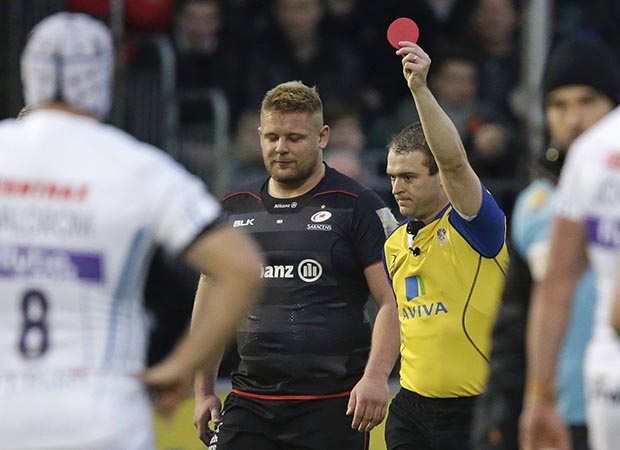 The focus on the refereeing of high tackles has grown massively since last weekend's games. The high tackles by Brad Barritt and Richard Barrington of Saracens on Exeter lock Geoff Parling, and also Ulster No.8 Sean Reidy on Scarlets scrum-half Aled Davies, put the spotlight on the issue immediately. However, what we need is a bit of perspective.
The focus on the refereeing of high tackles has grown massively since last weekend's games. The high tackles by Brad Barritt and Richard Barrington of Saracens on Exeter lock Geoff Parling, and also Ulster No.8 Sean Reidy on Scarlets scrum-half Aled Davies, put the spotlight on the issue immediately. However, what we need is a bit of perspective.
The BBC rugby broadcast team have a review every year before the start of the Six Nations that includes an elite referee telling us about any changes that had been made regarding the laws. What was said to us this time is that since the 2015 World Cup it has been explained to players that the tackle, and high tackle, are at the top of the agenda for match officials.
However, the idea that we are looking at a tackling law change – which is what we thought initially – is incorrect. Instead, what has happened is that the sanctions for high tackles have changed. One of the best comparisons is with a speeding offence, so that instead of the usual three points an offender is given, this time they get four or five points.
Overall, I agreed with the disciplinary panel which dealt with the Barritt-Barrington case, and believe it arrived at a fair and reasonable decision to give the Saracens captain a three-week ban while not punishing prop Barrington any further following his sending-off. How I read it was that Parling fell into Barrington's tackle after being hit and knocked out by a swinging-arm from Barritt – and that Barrington's offence would not have happened in the same way but for his team-mate's tackle.
Now players have to consider that if they go high then they might get six weeks rather than two, so it puts the responsibility back on them. In Reidy's case he was sin-binned controversially for a high wrap-tackle, and was punished further when a penalty try was awarded against Ulster.
What we have to remember with many of these cases is that while a disciplinary panel can see endless replays before coming to its decision, a referee has very little time to react.
There's also the likelihood that with every marginal tackle the players near the incident start appealing to the referee. With the crowd also on its feet, especially if there's a big screen, the pressure on referees when they go to the TMO review is often considerable.
The referee in the Saracens v Exeter game was Ian Tempest, who is relatively inexperienced at Premiership level. He can count himself even more unlucky because most of the more experienced elite referees said they had never had to make a refereeing decision on an incident like that in 15 years. To complicate things further, match officials are not just looking at whether a high tackle is accidental or reckless, but how much force is used in contact.
Another area where players are going to have to be much more careful is in kicking the ball out of a ruck. It is now a dangerous business, because if you misjudge it and are reckless enough to clip someone's head with your boot, then you're gone. Put simply, there is a lot more risk than there is reward.
Against that, what I've heard from elite referees has been incredibly positive – and if that positivity can be spread I am not sure that the new high tackle sanctions will have the dramatic effect that it seemed, at first, that they might.
My view is, we have to support referees throughout this period of change.
Situations like the illegal kick to the corner at the end of the Wasps versus Connacht game are different. That was so clearly a wrong refereeing decision under the existing laws that there was no excuse for it in a professional sport.
By comparison, high tackles are more subjective. For instance, when you're talking about the force of a tackle, at what point does it become excessive and go from being a yellow card to a red? That will be down to each referee to use his own judgement, and we have to be understanding of the difficulty involved.
What we have now is disciplinary panels studying video evidence and sometimes coming to different conclusions to referees – as with Barritt and Barrington. However, we should take as positive an attitude as possible towards referees because they are making difficult decisions in a very short time-frame, and those decisions are in the interests of player welfare. That deserves support, and thankfully there's been understanding of the predicament that Tempest was in.
Rugby Union is gladiatorial, sometimes beautiful, and it also generates huge emotion. We all get caught up in the moment, and sometimes referees are no different. In front of 82,000 fans at Twickenham, or 75,000 at the Millennium Stadium, it's a cauldron when something happens to a home player.
If a referee thinks a high tackle needs to be reviewed they have to block out the emotion coming at them from players and supporters, while at the same time sifting what the assistant referees and the TMO are saying. He needs to ask if it is late, or dangerous, accidental or deliberate, often while the game is going on, and process that information while he's on the move.
Any referral has to be a slick, accurate process in which the referee, assistant referees, and the TMO work in sync. Added to that, while I have no problem with late tackle replays being shown on the big screen, they should be in real time rather than slow motion, which often exaggerates impact.
In the great scheme of laws, their application, and sanctions for offending, this is a pretty new introduction. That's why, even though in modern life we want immediacy in most things, if referees and match officials need to spend time reviewing important incidents on the pitch, the rest of us should show patience – because if they get it badly wrong they are crucified.
In the best of worlds we don't want constant stop-start during matches, we want continuity of play. That means as little time spent in review as possible, and when Nigel Owens is refereeing and John Bevan is his TMO, it's usually fast and slick. That's what everyone should be aiming for.


























